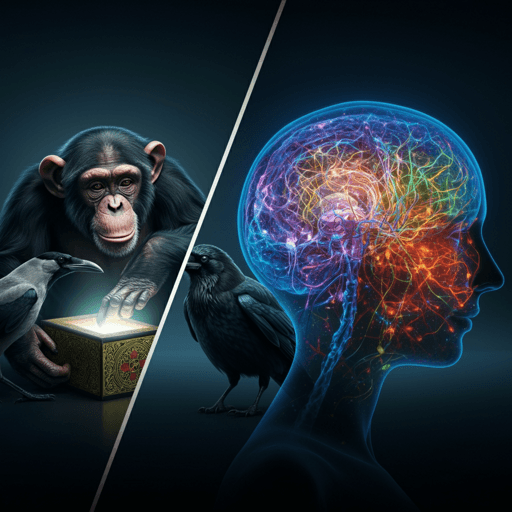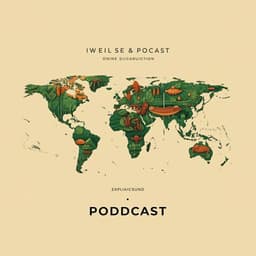
Psychology
To know or not to know? Curiosity and the value of prospective information in animals
V. Ajuwon, T. Monteiro, et al.
Curiosity drives animals to seek both instrumental and non-instrumental information that can be encoded in memory for future use. This comparative review examines laboratory tasks where individuals choose costly, advance information about uncertain outcomes—discussing prevalence, theoretical advances, and research limitations. Research conducted by Victor Ajuwon, Tiago Monteiro, Alexandra K. Schnell, Nicola S. Clayton.
~3 min • Beginner • English
Introduction
The paper addresses how and why animals seek prospective information that cannot be used instrumentally to increase immediate rewards. It situates curiosity within the broader context of decision-making under uncertainty, contrasting instrumental (extrinsically valuable) information seeking with non-instrumental (intrinsically valued) information seeking. Curiosity is framed as an intrinsic motivation to acquire information to reduce uncertainty or fill information gaps, potentially yielding long-term cognitive benefits through enriched world models and memory. The authors adopt a comparative approach to examine whether nonhuman animals exhibit curiosity-like behavior, focusing on laboratory paradigms where animals can choose to obtain advance information about uncertain outcomes without the ability to use that information to improve payoffs. The goal is to evaluate evidence across species, interpret mechanisms underlying such preferences, and outline implications for the evolution and cognition of curiosity-driven behavior.
Literature Review
Empirical approaches to animal curiosity include: (1) novel object and orienting paradigms that measure reactive inspection and habituation to novelty, often using physiological markers (e.g., pupil dilation), as quantitative indices of curiosity; (2) active novelty seeking, such as gaze-shift tasks in monkeys where subjects generate novel stimuli independent of reward, and optogenetically induced novelty-seeking in rodents; (3) latent learning and exploration studies (e.g., rats exploring mazes without reward); and (4) puzzle-solving by monkeys without extrinsic reinforcement. A central contemporary approach is the non-instrumental (also termed paradoxical or suboptimal) choice paradigm: subjects choose between an option that provides immediate, predictive cues (Info) about impending reward/no-reward outcomes and a non-informative option (NoInfo) that withholds such cues until outcome delivery. Info cues cannot be exploited to increase net reward and often come at a cost. Historically related to observing-response research in pigeons and rats, this paradigm has revealed robust Info preferences across humans, macaques, rats, mice, pigeons, and starlings, with notable exceptions (e.g., goldfish showing no preference). The literature debates whether Info preference reflects curiosity (information as a primary or negative reinforcer via uncertainty reduction), conditioned reinforcement of ‘good news’ cues, anticipatory savoring, or extrinsic foraging mechanisms misapplied to laboratory settings. Comparative findings suggest species differences (e.g., birds often showing strong Info preferences, sometimes even when Info is much less profitable; rats show cost sensitivity; goldfish no preference). Neural evidence in primates and rodents links information value encoding to midbrain dopaminergic systems and orbitofrontal cortex.
Methodology
This article is a critical, comparative narrative review; it does not report a preregistered search or meta-analytic methodology. The reviewed experimental literature commonly employs non-instrumental choice tasks with the following structure: subjects choose between two options that both lead to a brief delay and probabilistic outcomes (reward vs no/low reward). The informative option (Info) immediately presents a cue predicting the eventual outcome (e.g., “good news” vs “bad news”) but provides no opportunity to alter the outcome. The non-informative option (NoInfo) presents neutral cues, keeping the subject uncertain until the outcome occurs. Across studies, Info frequently has a lower reward probability or magnitude than NoInfo, rendering the acquisition of information costly. Choice responses vary by species and apparatus (e.g., lever press, peck, zone entry). The review also covers related paradigms: observing responses (actions to obtain predictive cues without changing reward rate), novelty-seeking via gaze-contingent stimulus generation, latent learning in mazes, and puzzle engagement without extrinsic reward. Neurophysiological studies in humans and nonhuman primates and rodents assess dopaminergic and cortical representations of information value, timing preferences (earlier information valued), and computations related to uncertainty.
Key Findings
- Robust preference for informative options: Humans, macaques, rats, mice, pigeons, and starlings often choose Info even when it cannot improve net rewards and may be costly. In some bird studies, Info is preferred even when up to five times less profitable than the alternative. In contrast, goldfish showed no Info preference despite learning contingencies.
- Information as reward/uncertainty reduction: Midbrain dopamine neurons encode subjective information value in humans and macaques; orbitofrontal and cortical neurons represent information value in mammals. Preference for Info can increase with uncertainty and for earlier vs later information, consistent with the aversiveness of prolonged uncertainty. However, across species this is mixed; for example, pigeons often do not seek information that only signals negative outcomes.
- Conditioned reinforcement/good news asymmetry: Cues predicting reward become strong conditioned reinforcers that bias choices toward generating ‘good news’ stimuli, while ‘bad news’ cues are weak/inhibitory. This account explains many findings and aligns with anticipatory utility and savoring models; some models integrate uncertainty reduction as contributing to the reinforcing properties of good news cues.
- Extrinsic urges/foraging-based accounts: Preferences may reflect mechanisms adapted for natural settings where advance information is instrumentally usable; in lab contexts, these mechanisms misfire, producing strong Info preferences even when suboptimal. Preparation hypotheses suggest Info allows better preparation for outcomes (or disengagement on unrewarded trials), though such benefits may not explain preferences when Info is very costly.
- Comparative trends and constraints: Birds (pigeons, starlings) often show strong Info preference and less sensitivity to reward loss compared to mammals; rats display cost sensitivity; a tested fish (goldfish) showed no preference, implying species differences in mechanisms. Evidence indicates multiple mechanisms may operate simultaneously (e.g., uncertainty reduction and conditioned reinforcement in rats and monkeys).
- Task and timing features: Info tasks typically include brief pre-outcome delays (often around 10–15 s). Earlier delivery of information is valued more than later information in humans, monkeys, and starlings.
Overall, the field converges on the conclusion that many animals attribute subjective value to prospective information, though the precise mechanisms vary by species and context.
Discussion
The review evaluates whether Info preference in non-instrumental tasks reflects curiosity or alternative processes. Evidence from primates and humans supports an intrinsic drive to reduce uncertainty and encode information value in dopaminergic and cortical circuits, consistent with curiosity. Yet, strong roles for conditioned reinforcement of reward-predictive stimuli, anticipatory savoring, and foraging-optimized mechanisms misapplied to lab contingencies are also supported. These mechanisms are not mutually exclusive and may co-occur, varying across species and task parameters. The findings prompt a rethinking of decision-making models to incorporate intrinsic information value. Open questions include the breadth of outcomes animals will seek information about (beyond food magnitude/timing), sensitivity to information valence, state- and context-dependence of information seeking, and how information acquired non-instrumentally is later used. The authors argue for developing behavioral criteria for “curiosity-like” behavior (analogous to episodic-like memory approaches), investigating metacognitive aspects (learning progress maximization), links to long-term memory use, and the modulation of curiosity by prediction errors and expectation violations. They emphasize expanding taxonomic coverage and ecological validity to understand evolutionary pressures and cognitive principles underlying curiosity-driven behavior.
Conclusion
Research using non-instrumental choice paradigms shows that many mammals and birds, and humans, often value prospective information enough to sacrifice primary rewards, implying subjective information value and potential curiosity-driven behavior. This has advanced theories of neural and cognitive mechanisms in decision-making. However, the strongest evidence for curiosity per se currently comes from primates, and cross-taxa generality—especially in invertebrates—remains uncertain. The authors outline future directions: broaden species sampling (including cephalopods like cuttlefish), examine ontogeny, test diverse information types (social, aversive, counterfactual), adopt open-ended and ecologically relevant paradigms, probe metacognitive/learning progress accounts, and assess how non-instrumental information is later deployed from memory. Addressing these will clarify how natural selection shaped information valuation, with implications for human cognition, mental health, and the evolution of intelligence.
Limitations
- Conceptual: No unified, operational definition of curiosity across species; reliance on inference without access to animals’ subjective states.
- Paradigmatic: Heavy dependence on a single class of tasks (non-instrumental choice) with short time horizons and primarily food-related outcomes; limited tests of information valence symmetry.
- Evidence base: Strongest support for curiosity-like uncertainty reduction is from macaques/humans; mixed findings in birds and rodents; goldfish show no preference, highlighting species differences.
- Alternative explanations: Conditioned reinforcement of ‘good news,’ savoring, preparation benefits, and foraging-based misapplication can explain preferences, complicating attributions to curiosity.
- Scope and methods: The review is narrative and does not report systematic search or meta-analytic methods; ontogeny is largely unstudied; substantial taxonomic gaps, especially in invertebrates.
Related Publications
Explore these studies to deepen your understanding of the subject.







